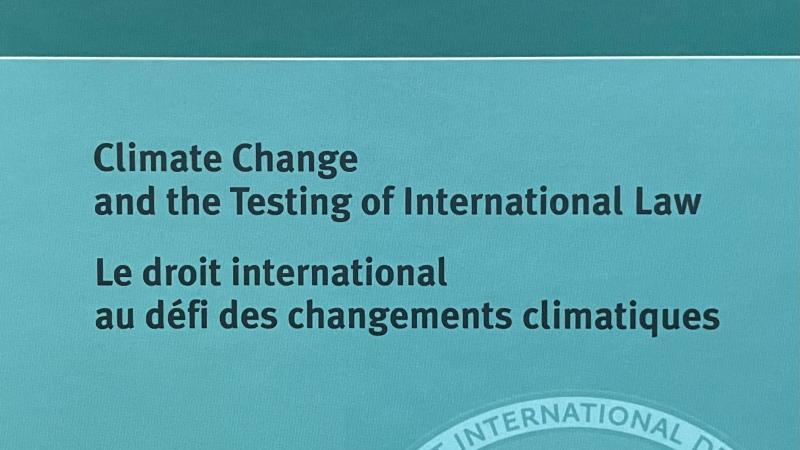
Climate change poses threats of great seriousness and urgency for humanity and the planet. As an issue that cuts across all domains of human activity, creates scientific uncertainties, and leads to wide-ranging socio-economic and environmental impacts, it also challenges conventional rules, sources, structures, institutions and approaches in international law. This volume contains the work of the 2022 Centre for Studies and Research on this important and timely topic of climate change and the testing of international law. Using the challenge of climate change as an experimental laboratory for international legal innovation, the contributions in this volume seek to measure the capacity of international law across a broad range of fields — from peace and security law, to investment law, trade, human rights and many other areas — to adapt and evolve, and as a catalyst for designing the international law of the future. It traces a progressive “climatization” of international law occurring under the transformative influence of the climate problem, highlighting both international law’s potential for creative responses, as well as areas where its rules and structures are not fit-for-purpose and require more radical overhaul to better match the scale and urgency of the challenge of addressing climate change.
Les changements climatiques font peser des menaces particulièrement graves et urgentes sur l’humanité et la planète. Objets d’incertitudes scientifiques, touchant tous les domaines de l’activité humaine et porteurs de conséquences socio-économiques et environnementales de grande ampleur, les changements climatiques affectent en profondeur les principes, sources, mécanismes et institutions du droit international.
Ce volume contient les travaux du Centre d’étude et de recherche en 2022 qui ont porté sur un sujet à la fois important et d’une grande actualité : la mise à l’épreuve du droit international par les changements climatiques. En voyant dans le défi posé par les changements climatiques un laboratoire expérimental, les contributions réunies dans ce volume s’attachent à mesurer la capacité du droit international dans un large éventail de domaines (du droit de la paix et de la sécurité internationales, au droit des investissements ou du commerce, aux droits de l’homme et à bien d’autres encore) à s’adapter et à évoluer, et à servir de catalyseur pour fabriquer le droit international du futur. L’ouvrage témoigne de la « climatisation » progressive du droit international pour faire face au problème climatique. Il souligne de ce point de vue à la fois la flexibilité et les forces créatrices du droit international, mais aussi l’inadaption de certains de ses mécanismes et règles, qui requièrent des changements plus radicaux pour être à la hauteur de l’ampleur et de l’urgence du défi majeur que représente aujourd’hui la lutte contre les changements climatiques.
- Copyright Year: 2023
- Hardback
- Availability: Published
- ISBN: 978-90-04-68239-9
- Publication: 20 Nov 2023
Excerpt of Table of Contents – Table Des Matières
Introduction : The Reports of the Directors of Studies – Introduction :Les rapports des directeurs d’études
Chapter 1 – Chapitre 1
The progressive “climatization” of international law
Chapter 2 – Chapitre 2
La « climatisation » progressive du droit international
Chapter 3 – Chapitre 3
Hard et soft law: les sources du droit international au défi des changements climatiques
Chapter 4 – Chapitre 4
Le droit international Au défi des évolutions scientifiques : le rôle du GIEC
Chapter 5 – Chapitre 5
l’Ambition de et dans l’Accord de Paris
Chapter 6 – Chapitre 6
Obligations de due diligence et lutte contre les changements climatiques dans l’Accord de Paris: nouveaux éclairages
Chapter 7 – Chapitre 7
The climatization of international peace and security – A missed opportunity?
Chapter 8 – Chapitre 8
Le droit du commerce international au défi des changements climatiques : lever les totems et les tabous
Chapter 9 – Chapitre 9
Giving “teeth” to climate change related obligations through international investment law
Chapter 10 – Chapitre 10
The potential contribution of the BBNJ Agreement towards a sus- tainable international governance of marine renewable energy technologies
Chapter 11 – Chapitre 11
Le droit international au défi de la fragmentation: Interactions entre les régimes internationaux de protection de la couche d’ozone et des changements climatiques
Chapter 12 – Chapitre 12
Mobility in an era of climate change: a call for international law to fully realize itself
Chapter 13 – Chapitre 13
Climate crisis and the testing of international human rights remedies: forecasting the Inter-American Court of Human Rights
Chapter 14 – Chapitre 14
Quelles évolutions du droit international des catastrophes face aux effets des changements climatiques ?
Chapter 15 – Chapitre 15
Market mechanisms, corporations and article 6 of the Paris Agreement
Chapter 16 – Chapitre 16
Obscured by transparency? How the desire for depoliticisation hides the potential for facilitative compliance from expert review
Chapter 17 – Chapitre 17
Through the looking glass: climate change and the law of state responsibility
Chapter 18 – Chapitre 18
Le droit international au défi de la réparation des dommages causés par les changements climatiques
Chapter 19 – Chapitre 19
Judging without waymarkers? The engagement of domestic courts with international climate change law
Chapter 20 – Chapitre 20
Contre vents et marées : la politique juridique des Tuvalu face à la disparition annoncée des petits Etats insulaires
Chapter 21 – Chapitre 21
Testing the climate readiness of the international regime on terrestrial protected areas?